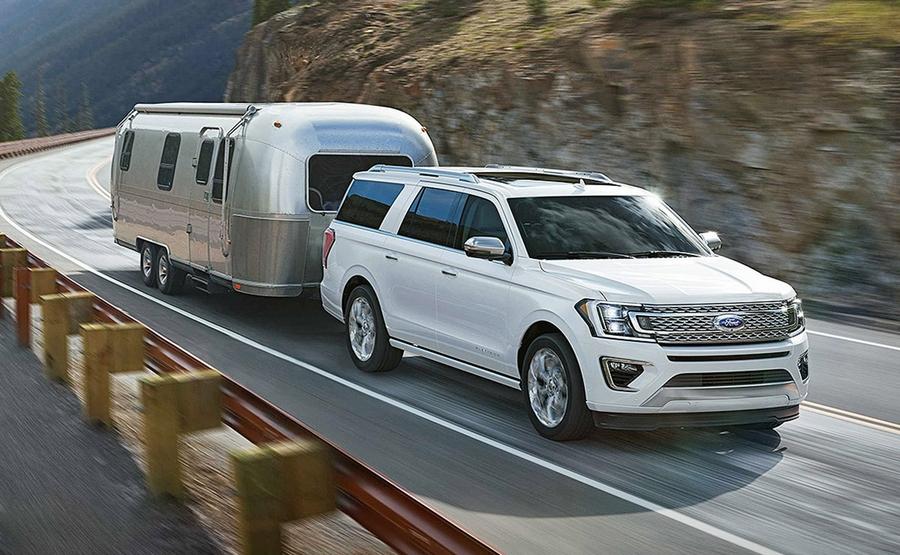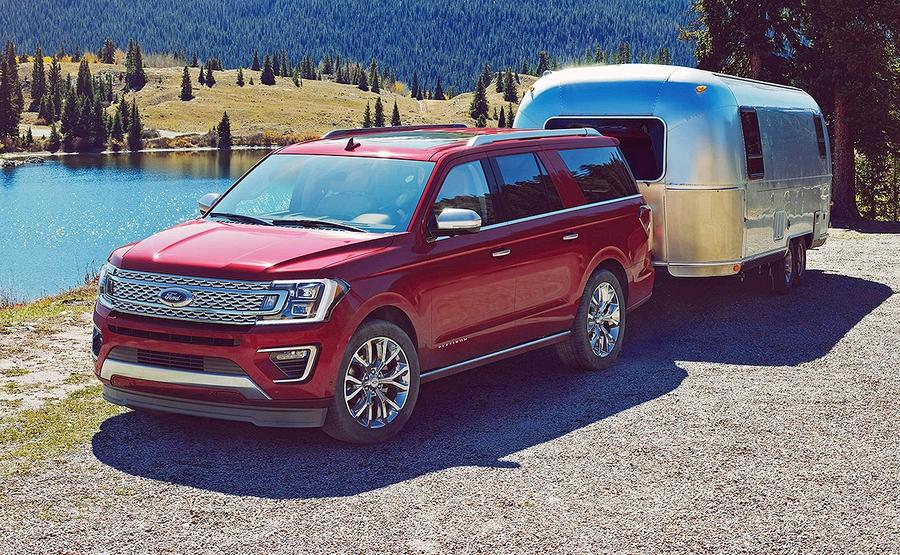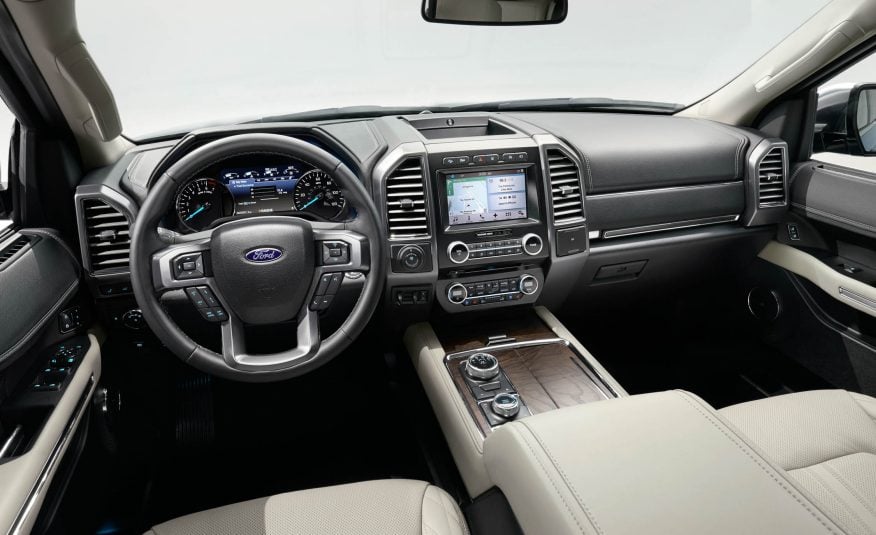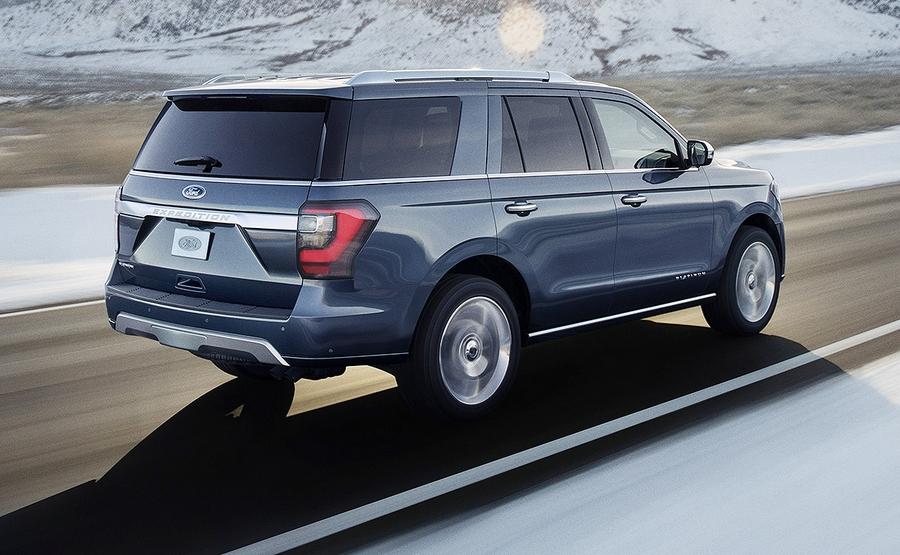2018 Ford Expedition
All-new 2018 Expedition First Look: Bigger, but Lighter
Like the F-150 it's based one, the new Expedition has an aluminum body
to shed weight while adding room for people and gear


We've been waiting for the aluminum-bodied 2018 Ford Expedition as the automaker expands its weight-saving strategies from pickups to the SUVs that share their underpinnings.
The result is an eight-passenger SUV that rides on a new frame; extends the wheelbase by 3 inches, overall length by an inch, and width by an inch; threw in a lot more tech; and still came up as much as 300 pounds lighter.
Ford was to reveal the SUV at an event in Dallas, and it will be on display later this week at the Chicago Auto Show.
The Exhibition made its debut for the 1997 model year, and although it has had upgrades, this is basically the second generation of the full-size SUV that competes with the Chevrolet Suburban, Toyota Sequoia, Nissan Armada, and future Jeep Wagoneer.
Ford says it has added 40 features and driver-assist technologies for the 2018 model year. The automaker didn't have to shut down the Kentucky Truck Plant in Louisville to retool the body shop for the shift from a steel body to aluminum, which is good because utility vehicles of all shapes and sizes are still hot right now.

In fact, 44 percent of the today's auto industry is SUVs. That's up from 33 percent in 2009, with millennials and baby boomers driving the shift from cars to utilities, said Michael O'Brien, Ford SUV group marketing manager. Globally, SUVs have grown 80 percent in the past five years, up to 1.7 million in 2016. Within that, the full-size SUV segment grew 22 percent in 2016.
The new Expedition goes on sale in the fall and will be offered in XLT, Limited, and Platinum trim levels for regular customers and an XL for fleets. There is also the extended Expedition Max, which is about 8 inches longer.
The 2018 model carries over the 3.5-liter turbocharged V-6 EcoBoost engine with auto stop-start, but it has been tweaked to squeeze out more power and is mated to Ford's new 10-speed automatic transmission operated via a rotary knob.
Performance and fuel economy will improve slightly, but Ford has not released specs yet. Executives are not talking about hybrid or diesel options at this point, but those are powertrains offered or planned for the F-150.
The available four-wheel drive and electronic limited-slip rear differential better adapt to road conditions, and the Expedition also adds the Terrain Management System from the Explorer.
The 2018 Expedition has a new, more rigid frame and retains its independent rear suspension and continuously controlled damping, which was originally exclusive to Lincoln. The Expedition is the only Ford-branded product to get the active shocks. There are 18-, 20-, and 22-inch wheels available, and 17s are an option for fleet vehicles.
Because 58 percent of buyers say towing is important, Ford is improving the capability from 9,200 pounds currently to ensure it is the best in the segment-but Ford is not providing figures yet. The Expedition also gets the F-Series' trailer backup assist, which makes launching a boat seem easy.
Visually, the beltline is higher. Not only is this for aesthetics but also to give the appearance of an even safer vehicle, especially with the new C-pillar design, which suggests more strength supporting the roof. The headlamps are nicely integrated into the grille.

Engineers said the 2018 model offered an opportunity to fix things such as entry to the third row, which is made easier with a second-row seat that manually tips, slides, and can perform its tumbling act even with a car seat in it. Having an independent rear suspension keeps the third-row seat low-and for 2018, the seat reclines. That's good because redefined families that transport three generations often require all eight seats, said Craig Patterson, Ford's marketing manager for large SUVs. Generation Xers are the top Expedition buyers, having moved up from the Explorer.
Ford has given the Expedition a panorama roof above the first two rows and a flat load floor below, which can accommodate a 4-by-8-foot piece of plywood with the push of a button to fold both rows flat. A cargo management system creates compartments with bins underneath and shelves above for gear, and a lip keeps items from rolling out when you open the rear hatch. Up top, a well-disguised space under the roof racks is ideal for looping a rope through to tie down a Christmas tree.
Inside, it has double the cubby space, a huge center storage bin, two glove boxes, and 17 cupholders.
In-vehicle Wi-Fi works for up to 10 devices, and the signal extends 50 feet-perfect in a campground. Passengers can charge at all seating positions; the vehicle has four 12-volt power outlets, six USB ports, a 110-volt outlet, and wireless charging.
The Expedition is equipped with Sync 3 and is compatible with Apple CarPlay and Android Auto. It also offers Sync Connect to use FordPass on your phone for starting, locking, or locating your vehicle remotely.
Mounted screens on the front-seat headrests entertain those in the second row. Those in the last row can use their own devices or watch live television through a partnership with Sling.
The 360-degree camera makes it possible to offer blind-spot detection, cross-traffic alert, lane keeping, and adaptive cruise control with stop and go ability.
Ford is adding five new SUVs by 2020, including the introduction of the EcoSport to the U.S., the return of the Bronco, an electric vehicle, and some Lincoln models.

